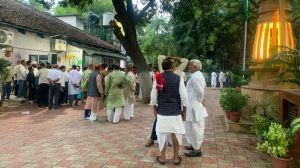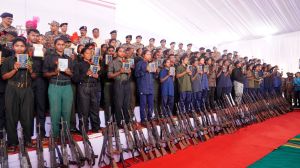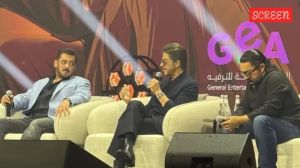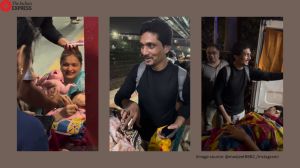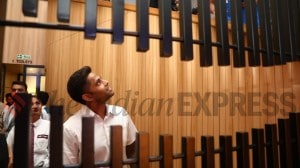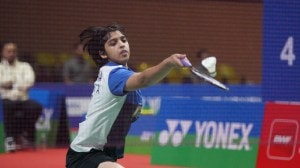My Gurus Story
A young classical musicians tribute to the eccentric genius of Kumar Gandharva is drawing crowds and acclaim.
A young classical musicians tribute to the eccentric genius of Kumar Gandharva is drawing crowds and acclaim.
Thirty-year-old Pushkar Lele was never a student of Kumar Gandharva,the legendary Hindustani classical musician who,struck with lung cancer early on in his career,sang for years with one lung,and whose voice forever carried the scars of his disease. But when Lele takes the stage at a series of packed concerts,called Kumar Darshan,it is the spirit of his antarik guru that presides. A screen behind him comes alive with a montage of Kumar Gandharvas photographs,and his own assured alaap and taankari become elements in a multimedia presentation on the Kumar Gandharva gayaki. He takes up the notes of Sar pe dhari ganga,a famous nirguna Gandharva bhajan,for example,and leads the audience on a journey of the life and times of Kumar Gandharva and his style of music. I never learnt from him, says Lele. But there is something about his gayaki that has been an inspiration.
Kumar Ganhdharva was an original,with an unconventional,slightly high-pitched voice. His interpretation of music was free of the confining rules of a gharana. He was a radical break from the prevailing order,a purists nightmare,but a musician who reached out to the people. He was unique in the way he used notes that were not part of a raga,in the innovations in taan and sargam,in his eclectic approach to music. He broke away from the upper-class moorings of classical music by emphasising the meanings of the lyrics,otherwise considered unimportant in Indian music.
Lele heard Gandharva once as an eight-year-old at a concert at Laxmi Krida Mandir. Eventually,I heard a slew of recordings by him. His thought process gave me the ability to question the systems of classical music. It is not about following the rules blindly. One has to let the music make conversation with you, says Lele.
The script-bound concert is Leles idea of introducing the younger audience to this musician,and is interspersed with audio-visual clippings of Kumar Gandharva,interviews of his close associates and montages of some of his rare photographs. The series of concerts have run to packed houses in India and abroad. Lele is all set to embark on the next set of concerts and is busy preparing for a Dharwad-to-Dewas yatra.
For Lele,fame and the attention from the audience and musicians have come after years of unlearning. He began learning music when he was eight. He recalls the days when his mother would drive him to a village called Dhayari on the outskirts of Pune on her rickety Bajaj scooter for his lessons. The rides continued till Lele was old enough to travel in a bus. He continued to learn from a slew of other gurus for 15 years.
In his early 20s though,he started looking for something more. I was questioning a lot of theories. I wanted to know why the lyrics were not considered important in a classical bandish. I wanted my gurus to tell me why we should use a certain kind of ornamentation with a certain taan but nobody was able to help, says Lele. He then met Vijay Sardeshmukh,a senior disciple of Kumar Gandharva. For the next six months,he only sang sa,the first note in the alankaar. The day I reached the centre of the swara,my next lesson began, says Lele,who adds that he had to unlearn the basics of music. It opened an unknown yet natural world for me. There is no point applying or forcing oneself on a bandish. One should let a bandish talk to you and that is what I do now, says Lele.
Leles efforts have been rewarded with acclaim from classical musicians. When somebody becomes a storyteller and tells the audience a tale of a great man,who existed and practised music in a voice that was not conventionally deep and sonorous but extremely staccato,the audience takes notice. This is exactly what Pushkar is doing. He is a wonderful singer and his multimedia presentation makes it interesting for the younger audience, says Grammy-winning musician Pandit Vishwa Mohan Bhatt,who is a regular at the Sawai Gandharva Mahotsav in Pune.
Vocalist Ashwini Bhide,an accomplished singer in the Jaipur Atrauli gharana style of singing,believes that Lele is successfully straddling the worlds of art and commercial success. If I look at recent times,Pushkar has taken to the Kumar Gandharva gayaki like Eklavya.
He has never met his guru but understands the nuances of a very difficult style of singing. If somebody understands a repertoire as intellectual as that of Kumar Gandharva,makes an effort to demystify it,and presents it to the new generation via new technology,it is commendable.
Through his efforts,Lele seems to have claimed for himself the legacy of a guru who never taught him. I do not follow the stereotypical rule of concentrating on the strict parameters of a composition. I have to allow this music to speak to me and this is how I can apply what I have learnt so far, he says. Next in line is a plan to revive the popular thematic concerts organised by Kumar Gandharva in the 1960s on the poetry of Tulsidas,Surdas and Tukaram. I want to try and bring back those times and that style, says Lele.






- 01
- 02
- 03
- 04
- 05








